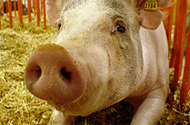Many pigs get contaminated with MRSA in the slaughterhouse

One in ten pigs gets the MRSA bacterium in livestock transport trucks, while sixty percent of pigs in slaughterhouses have the bacterium. Veterinary researcher Els Broens, Wageningen University, the Netherlands, finds this ‘very disconcerting’.
Broens trailed 117 pigs from the farm to the slaughterhouse. She inspected them for the presence of MRSA before and after the journey to the slaughterhouse, and after they were sedated before the slaughter. While none of the pigs had MRSA before the journey, 10 percent of them tested MRSA-positive afterwards. After the sedation in the slaughterhouse, the bacterium was found in sixty percent of the pigs. This research work was carried out jointly by Wageningen UR, the National Institute for Public Health and the Environment (RIVM) and the Animal Health Service (GD).
©
Waiting area
The pigs en route and in the slaughterhouse were not infected with MRSA, implies Broens. ‘The resistant bacterium was lodged in their noses but infection did not take place.’ The livestock trucks were cleaned after every journey. The animal waiting areas in the slaughterhouse were cleaned daily, but not throughout the day. Therefore, one batch of pigs could have infected another. In contaminated livestock trucks, twenty percent of the pigs became contracted the bacterium. In trucks which were not contaminated, no such cases occurred.
The pigs en route and in the slaughterhouse were not infected with MRSA, implies Broens. ‘The resistant bacterium was lodged in their noses but infection did not take place.’ The livestock trucks were cleaned after every journey. The animal waiting areas in the slaughterhouse were cleaned daily, but not throughout the day. Therefore, one batch of pigs could have infected another. In contaminated livestock trucks, twenty percent of the pigs became contracted the bacterium. In trucks which were not contaminated, no such cases occurred.
‘The waiting area for the pigs was hose-cleaned, but not disinfected, daily’, says Broens. ‘Throughout the day, droppings, bacteria and viruses were accumulated. The pigs spent a few hours, or even more sometimes, in this area. Therefore, they ran the risk of getting infected by MRSA. But it was extraordinary that the spread of MRSA happened so quickly among the pigs in the waiting area.’
©
©
Resistant
The Methicillin-resistant Staphytococcus aureus (MRSA) bacterium is resistant against various types of antibiotics also used in human healthcare. Humans and animals can get infected by MRSA when they have problems from an underlying disease, open wounds and skin disorders. Using the usual antibiotics to fight the infection often does not work.
The Methicillin-resistant Staphytococcus aureus (MRSA) bacterium is resistant against various types of antibiotics also used in human healthcare. Humans and animals can get infected by MRSA when they have problems from an underlying disease, open wounds and skin disorders. Using the usual antibiotics to fight the infection often does not work.
©
©
The MRSA bacterium does not cause food poisoning, unlike, for example, the salmonella bacterium. But transport and slaughterhouse workers run a big risk of getting the MRSA bacterium. They can infect other people in turn, says Broens.
©
©
Disinfect
Drastic measures to cut down infections by the MRSA bacterium in slaughterhouses – such as disinfecting the waiting area after every batch of pigs – are almost impossible in practice, says Broens. ‘I feel that the problem has to be tackled at its source: the farm.’ The MRSA bacterium is present in almost three quarters of the farms in the pig sector, as shown by earlier research.
Drastic measures to cut down infections by the MRSA bacterium in slaughterhouses – such as disinfecting the waiting area after every batch of pigs – are almost impossible in practice, says Broens. ‘I feel that the problem has to be tackled at its source: the farm.’ The MRSA bacterium is present in almost three quarters of the farms in the pig sector, as shown by earlier research.
©
Broens, attached to the Quantitative Veterinary Epidemiology chair group, has published her research proceedings in The Veterinary Journal this month. She hopes to obtain her PhD next year in this research area.
©











